“We Can Never Shutdown Production.” That was the first lesson I learned when I began my career in compressed air in 2003. At that time, Gentex Corporation consisted of three buildings which housed three separate air compressor systems. Now, more than 17 years later, we have ten buildings with air compressor systems. Understanding the importance of compressed air and how to maintain and improve the systems that produce it; helps a company’s bottom line.
Compressor systems often times are left to run themselves but are not set up to do so. Some operators find they are only able to do the bare minimum in maintenance and planning because of time, money, or both. The information contained in this article, will help the operator to assess his/her systems, and identify where these systems fall within a three-level category. There are many ways, and opportunities to make a compressed air system produce reliable and good quality air. The three levels discussed here could also be characterized as a “continuous improvement plan” which can be achieved over the course of time, and with the occasional investment of money.
The Three Levels build upon each other, and as each step is taken, more opportunity for improvement, monitoring, and finally cost saving can be achieved. It all starts with recognizing the necessity to be responsive and have answers to abnormalities within the air compressor system which produce frequent production downtime. This is a fundamental step for companies who want to control their air compressor systems. Second, once a decision is made to address these abnormalities/problems, the company will begin to implement Level Two— this is the beginning of a continuous improvement strategy. Finally, when reaching Level 3, the data collected can save time, money and make a system easier to manage.
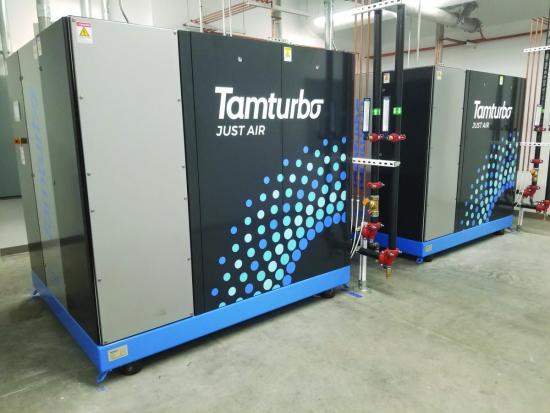
One air compressor as standby/backup. This unit is 100% oil free, with very low maintenance and variable speed drive.
Level One: The necessity to be responsive (this is the beginning of improving reliability). Identifying problems within the system and production issues at the end use point.
Step 1 Goal: Always have compressed air. When we had an air compressor fail, the problem at hand was usually obvious, the air compressor was down, and it needed fixing. If this was the only air compressor to support production, production would soon run out of air. This is the beginning of level one – Keep a dedicated air compressor for backup purposes only. I am not saying to keep it in standby and never run it, just always have one air compressor in the rotation as a standby, and for use when shutting down individual air compressors for scheduled maintenance. When management approached me with the cost figures for downtime it was easy to ask for the backup “standby” air compressor.
Step 2 Goal: Improve air quality. One way to greatly improve compressed air quality is to dry it after compression. For Gentex, dry air became very important as we grew. Just as adding a standby air compressor helped ensure that production would always have compressed air; we added a redundant air dryer into the system so production would have dry air if a breakdown occurred. This also allowed for maintenance to occur when needed, and not just on Holidays, when production was off, which are few and far between.
Step 3 Goal: Maintain air pressure at the end use points to reduce problems for machine operators. The tricky part came when production would say they have low air pressure; the pressure swings too much; and/or sometimes they would say they have no pressure at all. Troubleshooting these situations should have been easy, but I could not tell where the root cause was in the system. PSI gauges on the supply header were only sometimes working. There were very few, if any, pressure gauges at the point of use and often were in the wrong spot. One observation I noticed early on was that machine operators would watch the small gauge that comes with the regulator on the outlet side that is attached to the machine (that is if I was lucky to have a regulator), but of course there was never a gauge positioned before the regulator. As a result I would end up first troubleshooting the supply side of the system, and then the end use equipment. Operators usually did not believe the issue was the result of the regulator or internal to the unit using the air until I had psi gauges in the correct locations.
Step 4 Goal: Keep ahead of flow needs. Adding a flow meter in the main header to production gave me a quicker response time in troubleshooting the entire system. A flow meter can indicate if all the air compressors are putting out the rated flow. In instances where all air compressors are working, and we have low PSI on the plant floor, we would expect a high flow reading. Adding a flow meter in the main header will also help an air compressor operator know when the company is growing (adding production equipment) and can monitor when that growth will require an additional backup compressor to be added to the system.
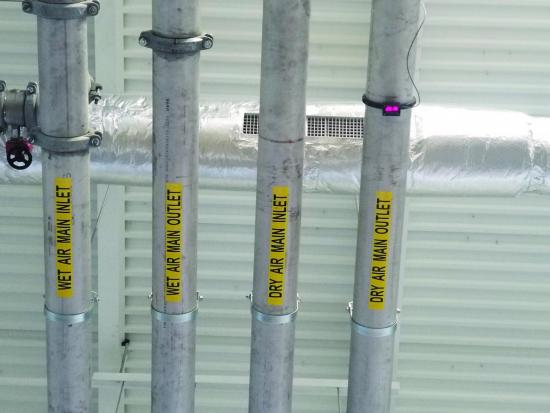
Compressed air flow meter on the main supply header to production.
|
Level One
This is where step 1 comes from – “The necessity to be responsive and have answers to pressure issues when they arise”. |
Level Two
After completing the goals for Level 1, it’s time to begin looking at system plumbing and air quality improvements. In managing the air compressor systems at Gentex, I have found areas for improvement within the systems. These improvements became evident whether it was a result of a breakdown, a flow supply problem, pressure, or quality issue. Many times, the root cause of a problem would inherently require a change anyway. There are things in the system that I believe are important to better your chances of having a reliable system. (Continued reliability, increase quality)
Step 1 Goal: Improve System Plumbing. In level one, we mentioned shutting down an air compressor for scheduled maintenance. Prior to installing isolation and bypass valves on the main header loops, and supply lines to production, the only way to complete the task was to shut down the whole system to get the job done. We had to fix the problem on Sundays, provided no production department needed the compressed air, or on a Holiday. The opportunities available to shut the whole system off was very limited. Adding bypass and isolation valves where possible, aided in our ability to maintain our machines while suppling flow to production.
As we made valve improvements, we discovered that our system was plumbed using black pipe, which appeared to be the standard for air compressor systems when I started in 2003 at Gentex Corporation. Much of the black pipe in our systems had flow issues due to under sizing, rust buildup and particle fallout.
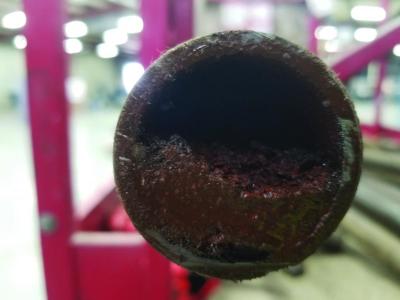
Rust and particle fallout from black pipe in air compressor system.
Using best practice guidelines, we changed to non-rustable pipe. In addition we now use slow sweeping and 45-degree elbows when possible. Stainless steel valves aid in keeping our system top notch.
Step 2 Goal: To ease the burden on the dryers we added a wet tank, preferable smaller (never larger) than the dry tank or an inline centrifugal condensate separator. Additional drains for all air compressor outlets and drains on the wet side of the header was implemented. Removing condensate is very important to protect air compressors and downstream processes so many condensate sources have two drains hooked in parallel in the event one fails. Adding dew point probes in the dry side of the system was another huge improvement. We positioned dew point probes on each individual dryer outlet as well. These improvements and the right pre/post filters helped ensure our quality was at its best.
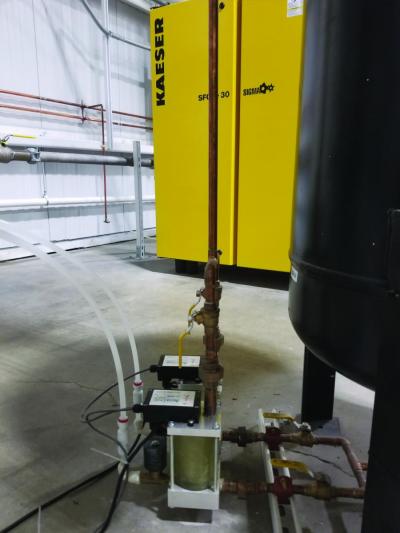
Using zero loss air drains for all condensates will save money. We have over 190 zero loss drains in operation. Some are plumbed in parallel for redundancy. Both have alarm contacts for email and text notification.
Testing our compressed air quality with an outside test lab has also become important. When production has a contamination issue one of the first places they will look is at the compressed air. Having documentation that the air is clean and dry will help production rule out the compressed air and speed up their root cause investigation. To protect production processes from contamination and reduce our carbon footprint we have gone to oil free air compressors in six buildings.
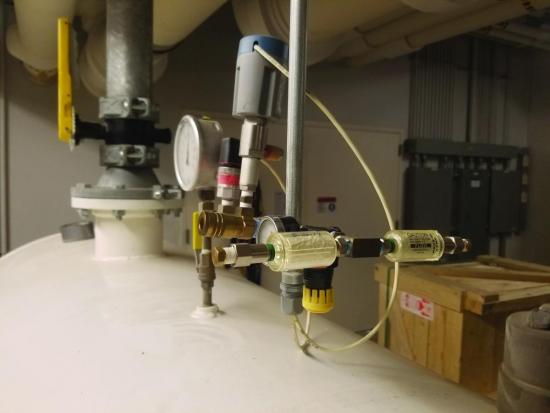
Adding mechanical oil and water indicators on the dry tanks added further assurance of air quality.
Step 3 Goal: Saving money. Saving money is very important so a variable speed drive (VSD) air compressor had to be in each system. In buildings without a VSD air compressor, flow controllers were installed to help smooth out pressure swings and to save money when lower pressure was used. As these changes were implemented, production stopped seeing pressure swings.
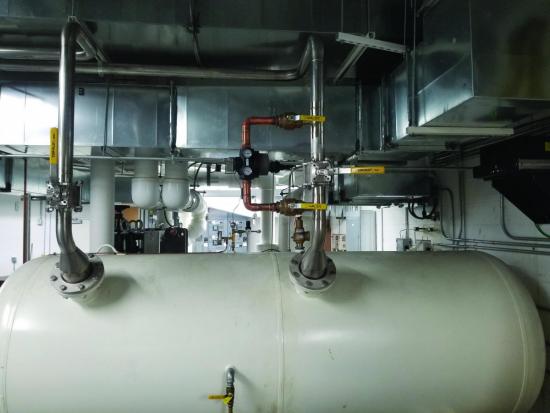
Building flow controller.
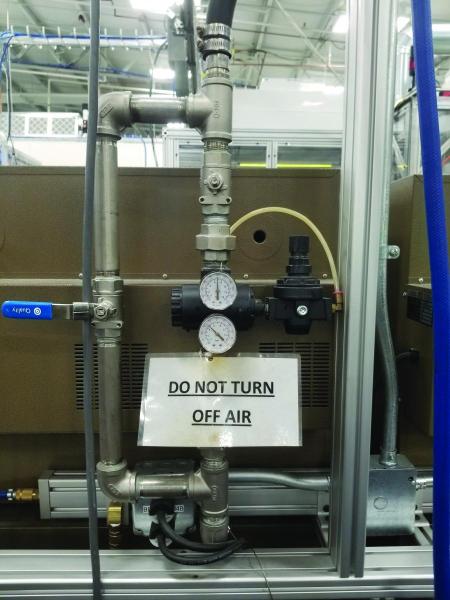
Many flow controllers are now used in lieu of PSI regulators.
Saving money also came from using the heat of compression. Our water treatment processes used in production would get down to 35 degrees Fahrenheit in the wintertime and up to 65 Fahrenheit in the summer. By taking the heat from the air compressors, we could consistently deliver water 25 degrees above ambient water temperatures to production, saving on heating costs on the production floor. Approximately 95% of the production lines are suppled with water heated from the air compressors. We also use the heat for snow melt systems in the winter.
Compressed Air Leak Audits are the last step for level 2. Audits became an important cost savings practice starting in 2008. When compressed air leaks are found, they are documented for cost of cfm lost and then fixed. Many utility companies will give rebates to companies who have leak audits completed. Not to mention that leaks, unchecked, continuously cost the company money.
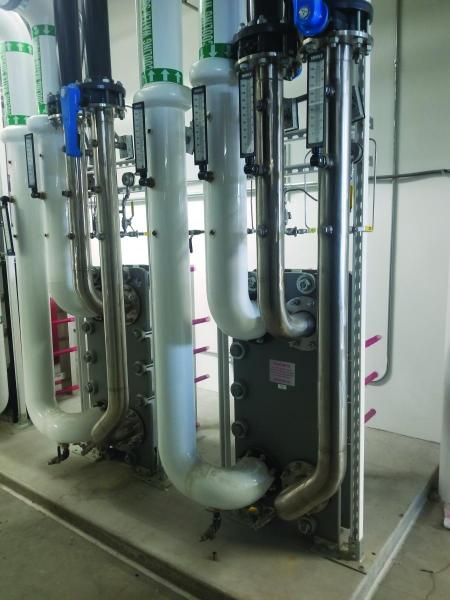
Heat of compression is recovered and effectively used to heat water.
|
Level 2
|
Level 3
Keeping the system dynamic – Our compressed air usage can change very rapidly. The largest changes occur when production starts and stops. Having the air compressors respond quickly and efficiently during these times is important. I wanted to be proactive by knowing when a change did occur in real time, and be able to anticipate when these and other changes might occur that would have an impact on production or the compressed air system and equipment.
Being alerted when changes occur, and ascertaining if it is normal, abnormal, efficient, or inefficient can save money and time. Setting the systems up to monitor themselves was the answer I needed. I was able to bring the system to the next level by adding an air compressor control system that could manage all the data and control the air compressors.
Step 1 Goal: Get the information. Install a central air compressor controller to manage air compressor output and make all air compressors in the system work together. At the company I was able to narrow my pressure band which allowed me to lower the plant pressure while still providing adequate pressure to each production line. This saved the company money. As an added incentive, many Power Companies offer rebates for installing and using a central controller. Another reason to install a central air compressor controller is that the controller also gave us a place to gather information from.
INSERT IMAGE: PIC9.JPG

Click to enlarge.
Step 2 Goal: Be on top of the Data. Use central air compressor controller or building control program to monitor and data log in real time remote monitoring devices. I was able to view and monitor changes like pressure, dew point, KW, air compressor and dryer faults, which all are important to know in real time to keep the system dynamic.
Step 3 Goal: To be proactive. Begin Benchmarking. I then used the central controller to monitor hundreds of data points which we had installed in the air compressor systems and other processes. I needed this information in real time to expedite response time, to answer questions regarding the system, and to ensure system performance. Bench marking information became critical in the overall process. I was now able to respond quickly when a change has happened or can have a plan in place when informed a change will happen. Incidentally, the central controller needed to have Kw meters to run the air compressors, and by coupling this with flow meters and pressure transmitters, we had a continuous energy audit online 24/7.
The compressed air data points we watch are:
- Kw Meters.
- Various air compressor faults.
- Air dryer faults.
- Condensate drain faults.
- PSI transmitters are in wet tanks, prefilters, post filters, dry tanks, main headers, plus the production floor.
- Flow meters on all main headers going out to production, and on each individual production line. Planning to implement individual air compressor flow meters also.
- Dew point transmitters on dry tanks and each individual dryer. And on the plant floor.
- Compressor cooling water temperatures.
- Heat of compression processes (production) temperatures.
- Other data points for nitrogen and purified water processes.
In addition to Benchmarking, the central air compressor system notifies us when any part of the system falls out of the norm. All the data inputs that monitor the quality and reliable of the system have alarm notifications. These alarms will be sent via email, text, or both for a quick response time. Many of these data inputs are set up so we can be proactive. Being proactive means for me that we are providing “system improvements” instead of “system repairs”. And when air compressor managers make system improvements, I hope that for them, it means production has not yet seen a pressure issue.
The data monitoring that our central controller performs, enabled me to move to a proactive approach for air compressor system management. Now I plan for preventive maintenance and system improvements which has increased our production up-time. And since as stated before, pressure, flow, and air compressor amperage is monitored; we have a 24/7 air compressor audit at our fingertips. Basically, I can manage our air compressor systems from my desk or anywhere in the world using the internet.
|
Level 3
|
Conclusion
In closing, there are many ways, and opportunities to make a compressed air system produce reliable and good quality air. The need to be responsive because of production problems with the compressed air will make a company reach Level 1 quickly. Completing level one will put a compressed air system in a position to be more dependable and allow time to make improvements for reaching Level 2. When operators have worked in Level 2 for a period of time, we begin thinking of what we can do to be proactive (Level 3), and to make the system truly run itself while saving money.
Today I am looking forward to level 4, “The Cloud”!
About the Author
John Bilsky is experienced in engineering design/improvements and maintenance for compressed air, nitrogen, and water purification systems, including those involving reverse osmosis and deionized water. He also has in-depth knowledge of production, as well as management of capital projects. Bilsky serves as the Facilities Specialist at Gentex Corporation for Compressed Air, Nitrogen, and Purified Water, email: john.bilsky@gentex.com, LinkedIn: https://www.linkedin.com/in/john-e-bilsky-24715b10/.
About Gentex
Gentex supplies automakers with advanced electronic features that enhance driver vision and safety. Since its inception, Gentex has managed the evolution of rear vision, using the rearview mirror as a delivery mechanism for innovative features that help automakers deliver sophisticated, revenue-producing electronic content to the car.
As vehicle electrification and autonomous driving trends progress, Gentex technologies are converging to yield products that provide unprecedented advances in digital vision, car connectivity and dimmable glass.
To learn more visit www.gentex.com.
To read similar Automotive Industry articles visit www.airbestpractices.com/industries/auto.
Visit our Webinar Archives to listen to expert presentations on Compressed Air System Reliability at www.airbestpractices.com/webinars.




